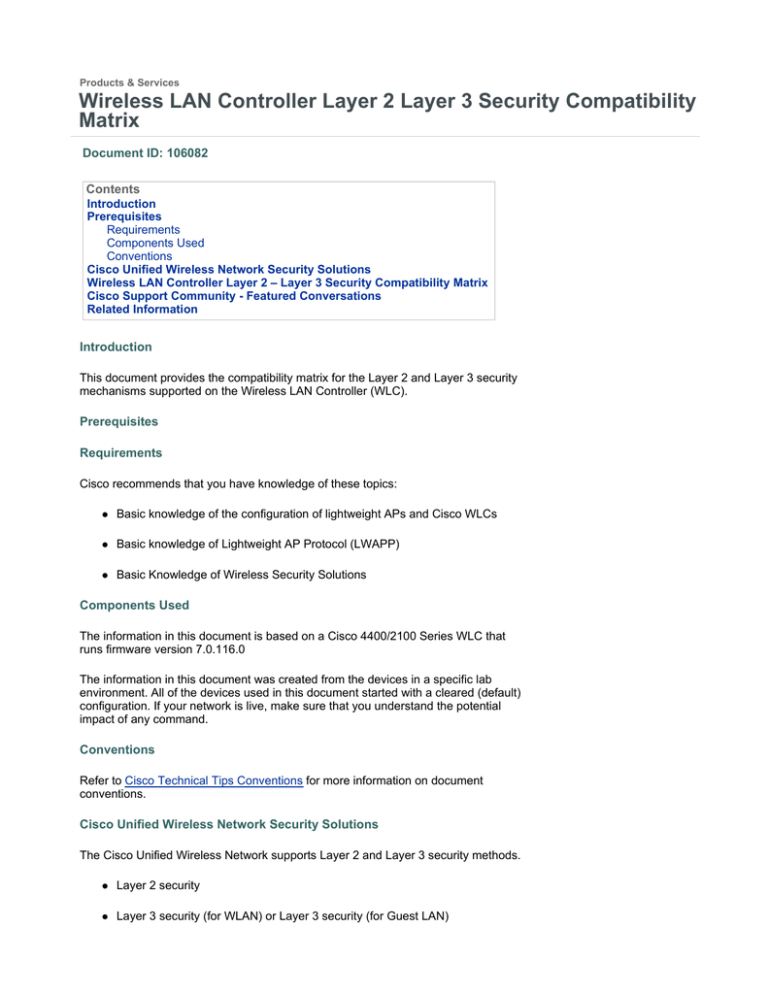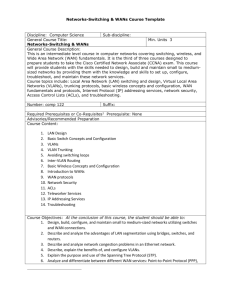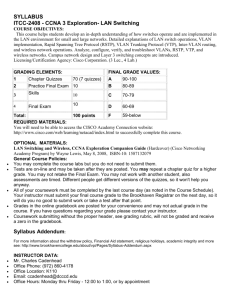
Products & Services
Wireless LAN Controller Layer 2 Layer 3 Security Compatibility
Matrix
Document ID: 106082
Contents
Introduction
Prerequisites
Requirements
Components Used
Conventions
Cisco Unified Wireless Network Security Solutions
Wireless LAN Controller Layer 2 – Layer 3 Security Compatibility Matrix
Cisco Support Community - Featured Conversations
Related Information
Introduction
This document provides the compatibility matrix for the Layer 2 and Layer 3 security
mechanisms supported on the Wireless LAN Controller (WLC).
Prerequisites
Requirements
Cisco recommends that you have knowledge of these topics:
Basic knowledge of the configuration of lightweight APs and Cisco WLCs
Basic knowledge of Lightweight AP Protocol (LWAPP)
Basic Knowledge of Wireless Security Solutions
Components Used
The information in this document is based on a Cisco 4400/2100 Series WLC that
runs firmware version 7.0.116.0
The information in this document was created from the devices in a specific lab
environment. All of the devices used in this document started with a cleared (default)
configuration. If your network is live, make sure that you understand the potential
impact of any command.
Conventions
Refer to Cisco Technical Tips Conventions for more information on document
conventions.
Cisco Unified Wireless Network Security Solutions
The Cisco Unified Wireless Network supports Layer 2 and Layer 3 security methods.
Layer 2 security
Layer 3 security (for WLAN) or Layer 3 security (for Guest LAN)
Layer 2 security is not supported on Guest LANs.
This table lists the various Layer 2 and Layer 3 security methods supported on the
Wireless LAN Controller. These security methods can be enabled from the Security
tab on the WLANs > Edit page of the WLAN.
Layer 2 Security Mechanism
Parameter
None
No Layer 2 security
selected.
WPA+WPA2
Use this setting in order to
enable Wi-Fi Protected
Access.
802.1X
Use this setting in order to
enable 802.1x
authentication.
Static WEP
Use this setting in order to
enable Static WEP
encryption.
Static WEP +
802.1x
Use this setting in order to
enable both Static WEP
and 802.1x parameters.
CKIP
Use this setting in order to
enable Cisco Key Integrity
Protocol (CKIP). Functional
on AP Models 1100, 1130,
and 1200, but not AP 1000.
Aironet IE needs to be
enabled for this feature to
work. CKIP expands the
encryption keys to 16 bytes.
Layer 2 Security
MAC Filtering
Description
Select to filter clients by MAC address.
Locally configure clients by MAC address in
the MAC Filters > New page. Otherwise,
configure the clients on a RADIUS server.
Layer 3 Security Mechanism (for WLAN)
Parameter
None
Description
No Layer 3 security
selected.
Use this setting in order to
enable IPSec. You need to
check software availability
and client hardware
compatibility before you
implement IPSec.
Layer 3 Security
IPSec
Note: You must have the
optional VPN/Enhanced
Security Module (crypto
processor card) installed to
enable IPSec. Verify it is
installed on your controller
on the Inventory page.
Use this setting in order to
enable VPN Pass-Through.
VPN PassThrough
Note: This option is not
available on Cisco 5500
Series Controllers and
Cisco 2100 Series
Controllers. However, you
can replicate this
functionality on a Cisco
5500 Series Controller or
Cisco 2100 Series
Controller by creating an
open WLAN using an ACL.
Select this check box to enable Web Policy.
The controller forwards DNS traffic to and
from wireless clients before authentication.
Note: Web Policy cannot be used in
combination with IPsec or VPN PassThrough options.
These parameters are displayed:
Web Policy
Authentication—If you select this
option, the user is prompted for
username and password while
connecting the client to the wireless
network.
Passthrough—If you select this
option, the user can access the
network directly without the
username and password
authentication.
Conditional Web Redirect—If you
select this option, the user can be
conditionally redirected to a
particular web page after 802.1X
authentication successfully
completes. You can specify the
redirect page and the conditions
under which the redirect occurs on
your RADIUS server.
Splash Page Web Redirect—If you
select this option, the user is
redirected to a particular web page
after 802.1X authentication
successfully completes. After the
redirect, the user has full access to
the network. You can specify the
splash web page on your RADIUS
server.
On MAC Filter failure—Enables web
authentication MAC filter failures.
Preauthentication Select the ACL to be used for traffic
ACL
between the client and the controller.
Over-ride Global
Config
Displays if you select Authentication. Check
this box in order to override the global
authentication configuration set on the Web
Login Page.
Displays if you select Web Policy and Over-
ride Global Config. Select a type of Web
authentication:
Web Auth type
Email Input
Internal
Customized (Downloaded)
Login Page—Select a login
page from the drop-down list.
Login Failure page—Select a
login page that displays to the
client if Web authentication
fails.
Logout page—Select a login
page that displays to the
client when the user logs out
of the system.
External (Re-direct to external
server)
URL—Enter the URL of the
external server.
Displays if you select Passthrough. If you
select this option, you are prompted for your
email address while connecting to the
network.
Layer 3 Security Mechanism (for Guest LAN)
Parameter
None
Layer 3 Security
Description
No Layer 3 security
selected.
If you select this option, you
are prompted for username
Web
and password while
Authentication
connecting the client to the
network.
Web
Passthrough
If you select this option, you
can access the network
directly without the
username and password
authentication.
Preauthentication ACL
Select the ACL to be used
for traffic between the client
and the controller.
Over-ride Global Config
Check this box in order to
override the global
authentication configuration
set on the Web Login Page.
Displays if you select Override Global Config. Select a
type of Web authentication:
Internal
Customized
(Downloaded)
Login Page—
Select a login
page from the
drop-down
list.
Login Failure
Web Auth type
page—Select
a login page
that displays
to the client if
Web
authentication
fails.
Logout
page—Select
a login page
that displays
to the client
when the
user logs out
of the system.
External (Re-direct
to external server)
URL—Enter
the URL of
the external
server.
Displays if you select Web
Passthrough. If you select
this option, you are
prompted for your email
address while connecting to
the network.
Email Input
Note: In controller software release 4.1.185.0 or later, CKIP is supported for use
only with static WEP. It is not supported for use with dynamic WEP. Therefore, a
wireless client that is configured to use CKIP with dynamic WEP is unable to
associate to a wireless LAN that is configured for CKIP. Cisco recommends that you
use either dynamic WEP without CKIP (which is less secure) or WPA/WPA2 with
TKIP or AES (which are more secure).
Wireless LAN Controller Layer 2 – Layer 3 Security Compatibility Matrix
When you configure security on a Wireless LAN, both Layer 2 and Layer 3 security
methods can be used in conjunction. However, not all the Layer 2 security methods
can be used with all Layer 3 security methods. This table shows the compatibility
matrix for the Layer 2 and Layer 3 security methods supported on the Wireless LAN
Controller.
Layer 2
Security
Mechanism
Layer 3
Security
Mechanism
Compatibility
None
None
Valid
WPA+WPA2
None
Valid
WPA+WPA2
Web
Authentication
Invalid
WPAPSK/WPA2PSK
Web
Authentication
Valid
WPA+WPA2
Web
Passthrough
Invalid
WPAPSK/WPA2-
Web
Valid
PSK
Passthrough
WPA+WPA2
Conditional
Web Redirect
Valid
WPA+WPA2
Splash Page
Web Redirect
Valid
WPA+WPA2
VPNPassThrough
Valid
802.1x
None
Valid
802.1x
Web
Authentication
Invalid
802.1x
Web
Passthrough
Invalid
802.1x
Conditional
Web Redirect
Valid
802.1x
Splash Page
Web Redirect
Valid
802.1x
VPNPassThrough
Valid
Static WEP
None
Valid
Static WEP
Web
Authentication
Valid
Static WEP
Web
Passthrough
Valid
Static WEP
Conditional
Web Redirect
Invalid
Static WEP
Splash Page
Web Redirect
Invalid
Static WEP
VPNPassThrough
Valid
Static-WEP+
802.1x
None
Valid
Static-WEP+
802.1x
Web
Authentication
Invalid
Static-WEP+
802.1x
Web
Passthrough
Invalid
Static-WEP+
802.1x
Conditional
Web Redirect
Invalid
Static-WEP+
802.1x
Splash Page
Web Redirect
Invalid
Static-WEP+
802.1x
VPNPassThrough
Invalid
CKIP
None
Valid
CKIP
Web
Authentication
Valid
CKIP
Web
Passthrough
Valid
CKIP
Conditional
Web Redirect
Invalid
CKIP
Splash Page
Web Redirect
Invalid
CKIP
VPNPassThrough
Valid
Cisco Support Community - Featured Conversations
Cisco Support Community is a forum for you to ask and answer questions, share
suggestions, and collaborate with your peers. Below are just some of the most
recent and relevant conversations happening right now.
Want to see more? Join us by clicking here
urgent - wireless lan controller and ap... carl_townshend 2 Replies 2 years, 12 months ago
Wireless LAN Controller 4400 multi-vlan... tcmob 2 Replies 5 years, 2 months ago
ASK THE EXPERT - WIRELESS LAN... ciscomoderator 157 Replies 4 years, 6 months ago
AP and Lan controllers to buy for... mahesh18 1 Reply 5 months, 2 weeks ago
internet connection for Wireless LAN... azzhaahir 3 Replies 2 years, 3 months ago
What is a Guest LAN? ericn8484 3 Replies 2 years, 7 months ago
Cisco Wireless Lan Manager par13_at_psu.edu 10 Replies 1 year, 11 months ago
WLC and LWAP initial setup bevans_at_bethpage.ws 22 Replies 3 years, 10 months ago
Authentication option for Wlan... quesne02_at_cn.ca 4 Replies 5 years, 2 weeks ago
Is it necessary to config 4400 in Layer... yytellmey 2 Replies 4 years, 11 months ago
Start A New Discussion
Subscribe
Related Information
Wireless LAN Controller and Lightweight Access Point Basic
Configuration Example
Lightweight AP (LAP) Registration to a Wireless LAN Controller (WLC)
Cisco Wireless LAN Controller Configuration Guide, Release 7.0.116.0
Wireless LAN Controller (WLC) FAQ
Technical Support & Documentation - Cisco Systems
Updated: Aug 04, 2008
Document ID: 106082
Contacts | Feedback | Help | Site Map
© 1992-2010 Cisco Systems, Inc. All rights reserved. Terms & Conditions | Privacy Statement | Cookie Policy | Trademarks of Cisco
Systems, Inc.




